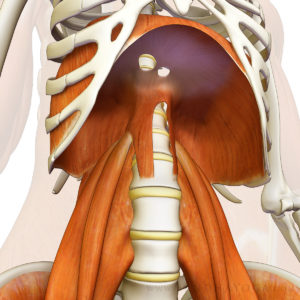As this article unfolded, I realized that it behaves very much the same as the diaphragm, it’s all over the place. It’s influence reaches the entire physical and emotional body. Please bear with it and look at the pictures and peruse the carefully placed links throughout the article. I’ve tried to keep this article fairly short, a lot of information has been left out. However, the links to other articles will meander through a bit more of the diaphragm’s story…
The diaphragm separates the upper and lower torso, and either directly touches or influences all the organs and muscles of the upper and lower torso via muscular connections. For example, since the diaphragm contracts and expands with each inhalation and exhalation, proper strength and flexibility are necessary for breathing and speaking.
The diaphragm influences the upper torso as it attaches to the inner aspect of the lower six ribs, the back of the sternum and the xiphoid process. Like a parachute, it wraps around the liver, stomach, spleen and pancreas. The esophagus and the abdominal aorta travel through the diaphragm, see photo of diaphragm, you will see two holes at the top. Fluctuating pressure created from breathing then influences blood flow, particularly blood flow back to the heart. From dailybandha.com, The pericardium, which is a sac surrounding the heart, has fascial connections to the diaphragm. Accordingly, the heart does move during breathing.

The diaphragm (touching the ribs) and the psoas muscle below, both attaching to the lumbar spine.
The diaphragm influences the lower torso as it also attaches to the front of the first, second and third lumbar vertebrae. And remember how the psoas muscle (click psoas to read article) also attaches to the front of the lumbar vertebrae. Specifically, the psoas attaches to all five lumbar vertebrae and the twelfth thoracic vertebrae, it is at this area that diaphragm flows into the psoas, which then has connections all the way to the feet. 
From dailybandha.com, Your thoracic diaphragm is the main engine for breathing, supplemented by the accessory muscles of your chest and abdomen. It is also an important postural muscle with functional connections to your pelvic floor. The point of bringing up some of the associations of this important postural muscle is that the health of the diaphragm affects health concerns such as lower back pain, incontinence, digestion, speaking, fear, anger and anxiety.
Knowing the attachments and associations of the diaphragm, this easily brings us to thoughts about the emotional aspect of the muscle. People and animals tend to hold tension in the area of the diaphragm and this forces us to take shallow breaths during fearful and anxious events. According to Chinese medicine, the Kidney (lumbar region) is the seat of courage and fear. The Kidney is also responsible for working with the Lung to deeply inhale. And the Heart in the upper torso is the seat of joy and anxiety. The diaphragm is between the Kidney and Heart and influences these energies and other muscles and organs. Let’s go further upward to the throat and consider speaking and breathing. When the diaphragm muscle is consistently tense due to anxiety or fear from situations where we are afraid to speak up for ourselves / others, or holding back tears, creating the “lump in the throat” – this creates stagnation in the area. Whether due to an injury or consistent stress, muscles will sometimes stay tense long after the event is over. The diaphragm physically touches many other muscles and organs, so it is best to keep the diaphragm free from constraint so that other muscles and organs are not placed in a position of tension as well. When we breathe, be aware of the downward contraction of the diaphragm during inhalation and the upward relaxation of the muscle during exhalation.
As far as acupuncture is concerned, we do not attempt to reach the diaphragm directly, this is unnecessary. We energetically reach the diaphragm in order to help balance the system. Since Chinese medicine and acupuncture addresses the whole person physically and emotionally, people find that they receive much more than they thought they would from their acupuncture visits.
Here is a link with excellent diagrams and guided breathing exercises :
http://www.dailybandha.com/2015/08/diaphragmatic-belly-breathing.html
